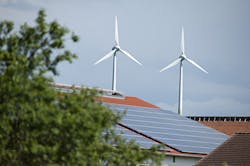The blockchain microgrid concept received a big boost today with infrastructure giant Siemens throwing its weight behind the New York startup developing the peer-to-peer trading system.
Siemens says it will collaborate with LO3 Energy, beginning in Brooklyn and eventually elsewhere in the U.S. and internationally.
A blockchain microgrid allows direct monetary transactions between peers in a microgrid. For example, an energy user in the microgrid might directly purchase extra power generated by a rooftop solar system on another building.
Viewed as a way to bypass conventional transaction platforms, blockchain technology already is used in other sectors, particularly in Bitcoin exchanges.
“In the world of finance, blockchain technology is rapidly advancing across many sectors, but in the energy market, things are comparatively different. With our microgrid solution in Brooklyn, we’ll demonstrate just the beginning of what blockchain can do in the transactive energy world,” said Lawrence Orsini, who founded LO3 Energy in 2012.
LO3 has been developing a blockchain microgrid in Brooklyn to allow local energy trading in Brooklyn’s Boerum Hill, Park Slope, and Gowanus neighborhoods.
The startup successfully completed preliminary tests of peer-to-peer transactions between Brooklyn neighbors in April. The approach dovetails with New York’s Reforming the Energy Vision (REV), a state strategy to decentralize the power grid.
The new partnership marks the first time that LO3’s blockchain technology will be integrated with a Siemens microgrid controller.
Blockchain technology offers a way to store and validate transactions that are trackable and tamper-proof on distributed systems, according to a news release issued by Siemens and LO3.
Projects like the one in Brooklyn use a combination of microgrid controllers and blockchain technology, so that a solar rooftop system feeds its excess electricity back into the local grid and receives payments from the purchasers. The microgrid also will balance out local energy production and consumption. The neighborhood already has over 1 MW of PV, which may be included in the transactive market.
“Just as our partner LO3 Energy, we are envisioning tremendous opportunities for the application of the blockchain technology, especially in microgrids with distributed and decentralized energy systems. Its big benefit is that it permits transparent, efficient trading between multiple participating systems and various stakeholders while taking grid-specific requirements into account,” said Thomas Zimmermann, CEO of Siemens’ digital grid business unit.
Siemens is pursuing the blockchain projects as part of its next47 unit launched last month to invest more than $1.1 billion over five years into decentralized electricity startups.
“The constant evolution at the grid edge requires advanced control, automation and data analytics technologies enabling secure, stable and reliable integration of decentralized energy systems as well as supporting the establishment of new business models,” said Ralf Christian, CEO of Siemens’ energy management division. “We’re convinced that our microgrid control and automation solutions, in combination with the blockchain technology of our partner LO3 Energy, will provide additional value for our customers whether on the utilities side or on the prosumer side.”
Blockchain plus controller means efficiency
Courtesy of Siemens
The platform creates efficiencies by not only managing generated and stored energy, but also by handling the consumers’ flexibility options, according to the companies.
In addition, the companies see their combined effort simplifying microgrid islanding and optimizing the use of existing resources within the grid infrastructure.
Based on insight gained in Brooklyn, Siemens and LO3 Energy say they intend to undertake additional blockchain microgrids and smart city projects. They plan to test out various business models to find a way to replicate the approach.
LO3 Energy said it is already seeking and signing up partners around the world to jointly develop microgrids that enable local energy trading based on blockchain technology. The company also recently opened an office in New South Wales to bring the transactive grid concept to Australia.
LO3’s technology recently won the ‘Best in Show’ award at the E.ON Supplier Innovation Day and the EPIC Energy Productivity Innovation award.
“To see so many CEOs of major companies in Europe enthused by what we are doing was encouraging – and to have Siemens connect with it so quickly and commit to work with us takes us to the next level,” Orsini said.
The announcement came the same day that Microgrid Knowledge released results from an independent survey that found Siemens to be the most recognized brand in microgrids.
About the Author
Elisa Wood
Editor-in-Chief
Elisa Wood is the editor and founder of EnergyChangemakers.com. She is co-founder and former editor of Microgrid Knowledge.
